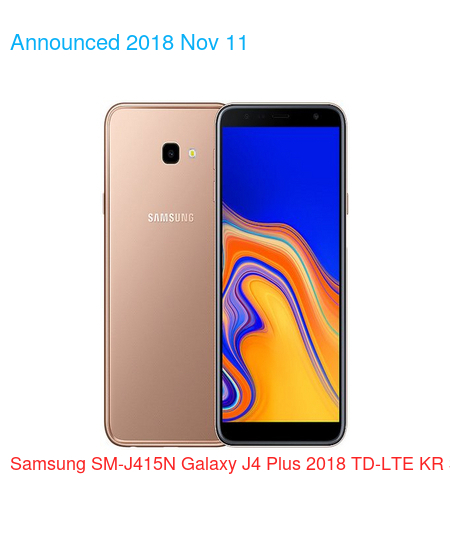| Brand | Samsung |
| Model | SM-J415N Galaxy J4 Plus 2018 TD-LTE KR 32GB |
| Released | 2018 Nov 12 |
| Announced | 2018 Nov 11 |
| Hardware Designer | Samsung Electronics |
| Manufacturer | Samsung Electronics |
| Codename | Samsung J415 |
| OEM ID | J415NZDTKOO |
| General Extras | Haptic touch feedback |
| Device Category | Smartphone |
| Width | 76.9 mm |
| Height | 161.4 mm |
| Depth | 7.9 mm |
| Dimensions | 3.03×6.35×0.31 inches |
| Mass | 178 g |
| Platform | Android |
| Operating System | Google Android 8.1 (Oreo) |
| Software Extras | Navigation software , Face Recognition |
| CPU Clock | 1400 MHz |
| CPU | Qualcomm Snapdragon 425 MSM8917, 2016, 64 bit, quad-core, 512 Kbyte L2, 28 nm, Qualcomm Adreno 308 GPU |
| RAM Type | LPDDR3 SDRAM |
| RAM Capacity (converted) | 3 GiB RAM |
| Non-volatile Memory Interface | eMMC 5.1 |
| Non-volatile Memory Capacity (converted) | 32 GB ROM |
| Display Diagonal | 152.6 mm |
| Resolution | 720×1480 |
| Horizontal Full Bezel Width | 10.14 mm |
| Display Area Utilization | 73.8% |
| Pixel Density | 274 PPI |
| Display Type | Color TN-TFT LCD display |
| Number of Display Scales | 16.8M |
| Scratch Resistant Screen | Yes |
| Graphical Controller | Qualcomm Adreno 308 |
| Dedicated Graphics Memory | 0.125 MiB |
| GPU Clock: | 500 MHz |
| A/V Out | No |
| Microphone(s) | stereo |
| Loudspeaker(s): | mono |
| Audio Output: | 3.5mm |
| Supported Cellular Bands | GSM900 , GSM1800 , GSM1900 , UMTS2100 (B1) , UMTS1900 (B2) , UMTS850 (B5) , LTE2100 (B1) , LTE1800 (B3) , LTE850 (B5) , LTE2600 (B7) , LTE900 (B8) , LTE700 (B17) , TD-LTE2600 (B38) , TD-LTE2300 (B40) , TD-LTE2500 (B41) bands |
| Supported Cellular Data Links | GPRS , EDGE , UMTS , HSUPA , HSUPA 5.8 , HSDPA , HSPA+ 21.1 , HSPA+ 42.2 , LTE , LTE 100/50 , LTE 150/50 data links |
| SIM Card Slot | Nano-SIM (4FF) |
| Complementary Phone Services | Voice transmission , Voice speaker , Vibrate , Speakerphone , ANC , HD Voice , VoLTE |
| SAR (head) | 0.690 W/kg |
| SAR (body) | 0.600 W/kg |
| Sec. Supported Cellular Networks: | No |
| Touchscreen Type | Capacitive multi-touch screen |
| Expansion Interfaces | TransFlash , microSD , microSDHC , microSDXC |
| USB | USB 2.0 |
| USB Services | USB charging , USB Host , USB OTG 1.3 , USB PD |
| USB Connector | USB Micro-AB |
| Bluetooth | Bluetooth 4.2 |
| Wireless LAN | 802.11b , 802.11g , 802.11n |
| Wireless Services | Wi-Fi Direct , Wi-Fi Tethering |
| NFC | NFC A , NFC B |
| FM Radio Receiver | No |
| Complementary Satellite Services | Simultaneous GPS , A-GPS , Geotagging , QuickGPS |
| Supported GLONASS protocol(s) | L1OF |
| Supported BeiDou system (BDS) | B1I BeiDou receiver |
| Camera Placement | Rear |
| Camera Image Sensor | CMOS |
| Number of effective pixels | 12.8 MP camera |
| Aperture (W) | f/1.90 |
| Zoom | 1.0 x optical zoom |
| Focus | PD AF |
| Video Recording | 1920×1080 pixel |
| Flash | single LED |
| Camera Extra Functions | HDR photo , Red-eye reduction , Slow motion video , Burst mode , Touch focus , Macro mode , Panorama Photo , Face detection , Face tagging , Smile detection |
| Aux. Camera Image Sensor | No |
| Aux. 2 Camera Image Sensor | No |
| Aux. 3 Camera Image Sensor | No |
| Aux. 4 Camera Image Sensor | No |
| Secondary Camera Placement | Front |
| Secondary Camera Sensor | CMOS |
| Secondary Camera Number of pixels | 4.9 MP sec. cam |
| Secondary Aperture (W) | f/2.20 |
| Sec. Built-in Flash | single LED |
| Secondary Camera Extra Functions | HDR photo , Panorama Photo , Face detection , Face retouch |
| Sec. Aux. Cam. Image Sensor | No |
| Built-in compass | Yes |
| Built-in accelerometer | Yes |
| Additional sensors | L sensor , P sensor |
| Protection from solid materials | Yes |
| Protection from liquids | Yes |
| Battery | Li-ion |
| Nominal Battery Capacity | 3300 mAh battery |
| Talk Time: | 28.0 hours |
| Market Countries | South Korea |
| Market Regions | Asia |
| Mobile Operator | KT Corporation LG Uplus Corporation SK Telecom |
| Added | 2024-06-19 |
Specifications data description of this 📱Samsung SM-J415N Galaxy J4 Plus 2018 TD-LTE KR 32GB📱
Title: Specification of the Device: A Comprehensive Overview
Introduction:
Welcome to our latest blog post, where we delve into the intricacies of a new device’s specifications. In this post, we’ll be taking a close look at the various components that make up this device, from its network capabilities to its battery life. So, whether you’re a tech enthusiast or someone who’s simply curious about what’s inside your gadgets, this post is for you.














